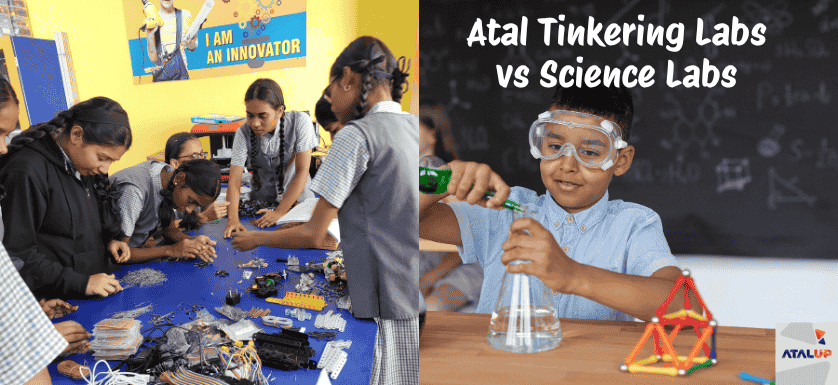
Most schools in India proudly show off their science lab; rows of glassware, charts on the walls, a whiff of chemicals in the air. These science laboratories are part of the standard setup and are considered essential for school academics. But here’s the truth: while a science lab in school helps students follow the manual, it rarely inspires them to build something of their own.
That’s where the Atal Tinkering Lab (ATL) changes the game. Atal Innovation Mission and NITI Aayog have started this initiative called Atal Tinkering Labs. It’s not just another science lab in school. It’s a space that sparks innovation. It lets students tinker, explore, and solve real-world problems using tools from the future, robotics, AI, IoT, and more.
Science Lab In School vs Atal Tinkering Lab – 6 Differences
1. Purpose of the Lab
A regular science lab in school- It helps students perform pre-decided experiments to understand concepts from their science lab manual. It’s more about proving existing theories.
But an Atal Tinkering Lab is a different universe. It pushes kids to think beyond what’s already written. They get to ask questions, find problems in the real world, and build their own working solutions using ATL equipment.
If a science lab teaches “What is,” ATL asks “What if?”
2. Science Lab Equipment vs ATL Tools
In a traditional science lab, you’ll find test tubes, flasks, litmus papers, models of organs, and so on, classic science lab equipment used to demonstrate biology, chemistry, or physics experiments.
But in an Atal Tinkering Lab, you’ll find smart kits, 3D printers, Arduino boards, sensors, DIY robotics kits, and even AI and coding modules. These aren’t just fancy gadgets; they help students build robots, apps, and prototypes.
Science labs help you observe; ATLs help you create.
3. Learning Style and Student Involvement
Let’s be honest, most of us remember watching our teacher perform an experiment in the school science lab, while we stood around copying results.
But in ATL, students get hands-on from day one. They work in teams, build models, fix errors, and learn by doing. It’s project-based learning that builds confidence and curiosity.
For instance, a science lab manual class 10 reinforces textbook theories like testing pH with litmus paper, studying laws of reflection/refraction, and observing onion cells under a microscope.
Whereas an Atal Tinkering Lab understands the real caliber of class 10 students. It involves activities like building a smart dustbin using sensors, designing a water level alert system, and creating a voice-controlled light system using Arduino.
Science labs follow instructions. ATLs break them to innovate.
4. Scope of Exploration
A science lab in school focuses on textbook chapters, like testing acids or observing cell structures. Useful, yes. But limited. Parents often notice that their kids are learning the same experiments they had learned.
ATLs go beyond textbooks. Students build smart farming models, create IoT-based health monitors, or develop AI-powered chatbots. They blend engineering, coding, design, and electronics in one project.
From experiments to entrepreneurship, ATL takes the leap.
5. Teacher’s Role in Each Lab
In a regular science laboratory, the teacher is the main performer. Students observe or follow steps. Teachers have been teaching the same bunch of experiments for several years.
But in ATL, teachers act more like facilitators or mentors. They guide students but let them lead. It’s a two-way street. ATL makes learning collaborative, not one-sided. The Atal Innovation Mission and vendors offer special teacher training to these teachers. Since the curriculum involves learning the latest technologies,
Science lab = instruction. ATL = exploration.
6. Skill Building and Student Growth
A science lab in school definitely plays an important role in helping students understand theoretical concepts in a practical way. It improves observation skills, and accuracy, and helps students score better on exams. However, the growth often stops at academic understanding. Most activities are pre-defined, and there’s little room to think beyond the manual.
ATL builds real-world skills, problem-solving, teamwork, creativity, communication, and critical thinking. These are skills students actually need in the careers of tomorrow, be it tech, medicine, design, or entrepreneurship.
ATL prepares kids not just for exams, but for life.
How ATALUP Makes It All Easy for Schools
Setting up an ATL might feel overwhelming; grant applications, equipment procurement, training, scheduling, and compliance, it’s a lot to handle.
That’s why ATALUP exists.
We help schools at every step:
- Check your eligibility for the ₹20 lakh ATL grant
- Apply and submit paperwork without confusion
- Procure ATL tools and equipment through GEM
- Train your teachers to run ATL sessions effortlessly
- Engage students with structured STEM activities
- Track progress and ensure long-term impact
Is your school eligible for
Atal Tinkering Lab
With ATALUP, schools go from setup to success, without stress. Want your students to lead India’s innovation story? Let’s start with one step: build an ATL. And let ATALUP walk with you.
Final Word
Why Your School Needs ATL, Not Just a Science Lab
Having a science lab in school is great. It helps students with their board exams and builds basic scientific temper.
But if you truly want your school to stand out, if you want your students to think, build, and lead, then you need an Atal Tinkering Lab.
ATL gives them the freedom to create, the tools to experiment, and the space to innovate.